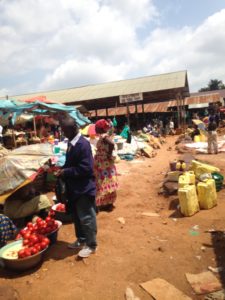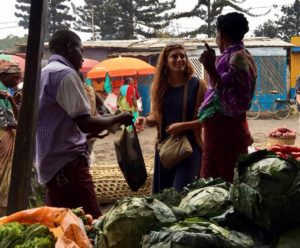
One of my favorite things to do when exploring and learning about my new surroundings is visiting the market. My first week in Goma I decided to go to a market near my neighborhood that I had heard about. I got directions from a friend, grabbed some empty plastic bags, and headed towards the lake. I turned left into a wide cobble-stoned street that had a slight incline. Motorists, cars, and pedestrians all juggled past each other. Along the road were small shacks, barbershops, and people selling tomatoes and onions. As I got closer to the road of the market, there was more activity as people came and went, trading their goods. There were young girls trekking yellow jugs of water from the lake up the hill and young men carrying goods to and from the market. There was a large crowd gathered outside one of these little shops. As I peeked inside, I could see a small television screening a movie in French. With intermittent electricity, this was the only chance young kids could watch a movie on their Saturday. I continued the walk up the hill and wondered how much further I had to go. I greeted passer-bys with the colloquial Swahili greeting, Jambo. Some returned the greeting, Jambo sana or greeted me in French. I asked a group of teenagers selling Airtel money on the corner, where the market was and they said I had to keep going straight and follow the curves of the cobble-stones.
As I made one final turn, I could see the main road on the other side as the place burst with activity. I reached the market, a large outdoor opening with wooden awnings and rows of sellers. There were rows dedicated to herbs and plants like tshitekutaku, a spinach-like green, pumpkin leaves, cabbage, and spinach. There also rows of bell peppers, tomatoes, onions, carrots, and potatoes. Most of these vegetables came across the border in Rwanda. My favorite was the fruit aisle filled with mangoes, tangerines, and avocado. The women selling the products spoke in Swahili and broken French so it was a perfect place to practice my Swahili language skills. The market wasn’t just one single entity. There were ladies selling chickens, brooms, and fabric all along the market street. Groups of young children crowded the market to sell plastic bags to customers. There were also ladies walking around with large, round baskets on their head selling sambasa, a local freshwater fish. All along the road was dried cassava, a starch used to make a Congolese speciality, ugali.

After buying my groceries and chatting with the children, I made the trek back. When I returned, my housemates were surprised that I had gone alone and by foot to the market. They explained how it was unsafe to venture into neighborhoods alone without someone from the community accompanying me and began to tell me stories of muzungus being targeted and attacked by street children. This was hard for me to hear because the way you get to know a community is by visiting, talking, and trying to follow daily practices as lived by the local population. I reflected on Congo’s long history of outsiders, namely UN and military officials, and their exploitation and at times harming of civilians and realized many people don’t want to welcome outsiders into their communities. I didn’t want to go to the muzungus market, which is conveniently located in the center of town and mostly caters to expatriates. The beauty of learning a new language is hanging out in outdoor markets or the local restaurant, getting a feel for the everyday lives of the people of Congo.